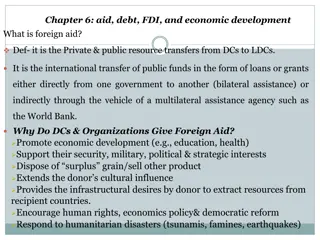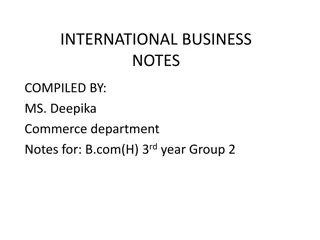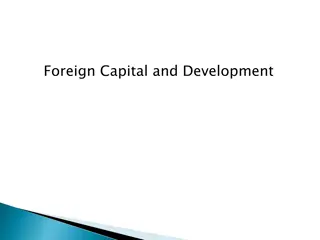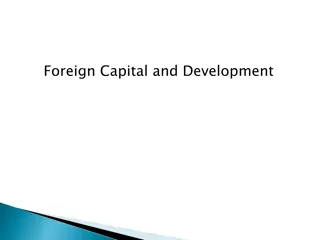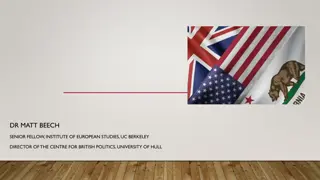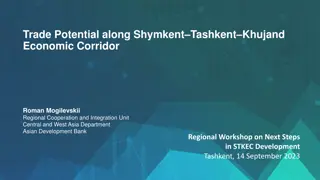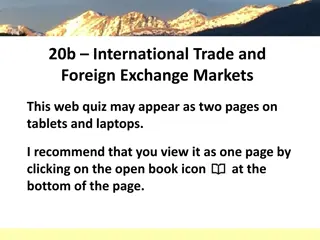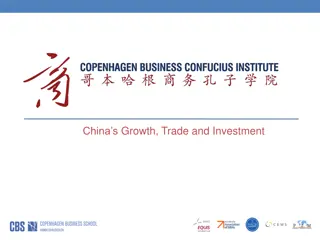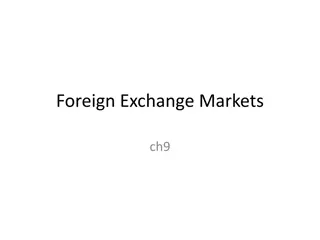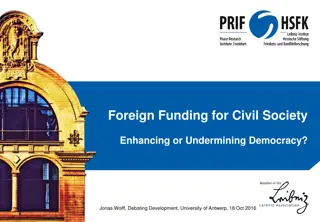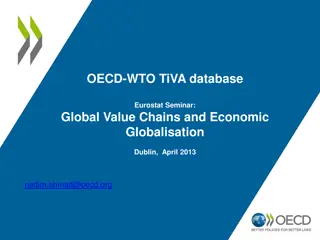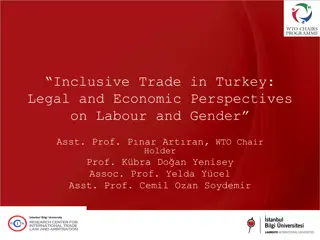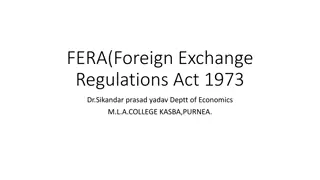Economic Development and Foreign Trade Policies in India
The economic development and policy in India with a focus on foreign trade policies are discussed in this paper. It covers the historical phases of India's trade policy, objectives, and the impact of economic development on foreign trade. The paper also delves into the various theories of foreign trade and the balance of payments between nations.
Download Presentation

Please find below an Image/Link to download the presentation.
The content on the website is provided AS IS for your information and personal use only. It may not be sold, licensed, or shared on other websites without obtaining consent from the author.If you encounter any issues during the download, it is possible that the publisher has removed the file from their server.
You are allowed to download the files provided on this website for personal or commercial use, subject to the condition that they are used lawfully. All files are the property of their respective owners.
The content on the website is provided AS IS for your information and personal use only. It may not be sold, licensed, or shared on other websites without obtaining consent from the author.
E N D
Presentation Transcript
B.A.Programme Semester VI Paper: Economic Development and Policy in India-II Course Teacher Dr.D.Appala Naidu
Topic -3 : Foreign Trade Policies Introduction The process and level of economic development of a country significantly influences the size, composition and direction of its Foreign Trade. Over the last decade, India s foreign trade-exprots and imports- has undergone a significant transformation both in terms of composition of commodities and direction. However, foreign trade expanded over the period with dominance of import growth vis-a-vis exports resulting in widening of the negative trade balance. The trade policy announced on 27 August 2009, in the backdrop of the economic crisis, kept the short-term objective of arresting the reversing the declining trend of exports and sought to provide additional support to those sectors badly hit by the recession in the developed world. 2
Objectives To give broader understanding of the foreign trade and it s policy. This unit given students an understanding of the aspects that how the various theories explain the development of foreign trade between the nations. The main objectives of this unit are: international * To provide an overview of various theories in foreign trade. * To evaluate the terms of trade between the nations. * To analysis the concept of Balance of Payment and Adjustment Mechanism in *To analysis similarities and differences between internal and trade. Balance of Payment. 3
Phasesof Indias trade policy Five phases in India s trade policy can be noted as follows: The first phase pertain to period from 1947-48 to 1951-52 The second phase covering the period from 1952-53 to 1956-57. The third phase from 1957-58 to June 1966 The fourth phase started after devaluation of the rupee in June 1966. And the last phase after 1975-76. 4
During the First phase up to 1951-52, Indias could have liberalised imports, but on account of placed by the united kingdom on the utilisation of the sterling balances, it had to continue wartime controls. A) Since our balance of payment (BPO) with the Dollar area was heavily adverse. B) This is also recessitated India to devalue her currency in 1949. C) By the large, the import policy continued to be restrictive during the period. During the second phase ( From 1952-53 to 1956-57), the liberalisation of foreign as a goal of trade policy. A) Import license were granted in a literal manner B) An effort also made to encourage export by relaxing export control, reducing export duties, abolishing export quotas, and providing incentives to exports. C) Liberalization led to a tremendous increase in our import, but export did not rise appreciably. D) Fast deterioration in our foreign exchange reserves (FERs) 5
During the third phase, which began in 1956-57, the trade policy was reoriented to meet planned economic development. A) A very restricted, import policy was adopted and import controls further screened the list of imported goods. B) On other hand a vigorous export promotion drive was C) It was in this period that India s trade policy was thoroughly reviewed by the Mudaliar Committee 1962. During the Fourth phase, started after the devaluation of rupee in June 1966. A) This period , the trade policy attempted to expand export and strongly liverlized imports, export promotion was given a big boost through the acceptance and implementation of the recommendation of the Mudaliar Committee (1962) . B) The major recommendation included on increased allocation of Raw materials to export- oriented industries, income tax relief on export earning, export promotion through import entitlement, removal of disincentives, and setting up of export promotion advisory council, a ministry of international trade. During the last phase (1975-76 onwards) , the government adopted a policy of import liveralisation, with a view to encourage export promotion. 6
Foreign Trade Policy 1991 The commerce minister, Mr.P.Chidambaram, announced a major overhaul of trade policy on july4, 1991 entailing 1. Suspension of cash compensatory support, 2.An enlarged and uniform REP (replenishment) rate of 30 per cent of FOB(Free on board) value. 3.Abolition of all supplementary licenses. 4.Abolition of unlisted OGL (Open General License). 5.Removal of all import licensing for capital goods and raw materials. After the announcement of new Industrial Policy in 1991 and opening of Indian markets for free competition in the whole world and creates hope for the Indian economy to came in the level of subsistence but only the New Industrial Policy is not sufficient to recover the world s largest economy as a result on 31 March, 1992, a new trade policy was announced by the Government of India has marked the Estelar 71 departure for all the previous trade policies because the previous trade policies does not show such an value changes for the improvement of foreign trade position of India. This policy is therefore important and unique because it has been announced after the implementation of the New Industrial Policy of 1991 and rather than this policy almost lifts all kinds of state control and regulations. It also abolishes the previous licensing environment form the Indian economy. In this policy except (Negative List) all the commodities can be imported with out any kind of tariff imposition on them. The private sector is allowed to import the commodities like raw material and capital goods without the intervention of government, but besides this the exports obligations 7
The steps were also taken to boost the domestic industrial productions. The some more aspects of the EXIM policy of (1992 Introduction of the duty free exports promotion of capital goods (EPCG) scheme. Strengthening of the advanced licensing system. The creation of suitable frame work for integrating Indian foreign trade in to the internal economy. The Indian industrial products to achieve the best quality of products so that they could stand in front of the high internat The research and development should be promoted to attain the technological modernisation and up gradation of Indian industri Any how the Indian government in order to liberalization the imports and boosts the exports and to bring the stability a 8
EXIM Policy of 1997-2002 The policy of 1997-2002 has brought a new concept in the trade policies of Indian and provide Indian economy a gateway to liberalization and modernisation by which the Indian economy is able to integrate with the different and developed economies of the world. The policy contains a number of significant features. The most controversial (VABAL) value based license scheme has been abolished and 542 items have been transferred from the restricted list to special import license (SIL) and freely importable list. The new Entitlement passbook scheme has also been introduced. Objective of the EXIM Policy 1997-2002 The principal objectives of the Export Import Policy 1997-2002 are as follows: (I) To accelerate the economy from low level of economic activities the high level of economic activities by marketing it a globally oriented vibrant economy and drive maximum benefits from expanding global market opportunities. (II) To create new employment opportunities and encourage the attainment of internationally accepted standards of quality. (III) To give quality consumer product at practical prices. 9
Highlights of the EXIM POLICY 1997-2002 Period of the Exim Policy: This policy is valid for five years instead of three years as in the case of earlier policies. It is effective from 1st April 1937 to 31st March. very important feature of the policy is liberalization. It has substantially eliminated licensing, quantitative restrictions and other regulatory and discretionary controls. All goods, except those coming under negative list, may be freely imported or exported. Imports liberalization: of 543 items from restricted list 150 items have been transferred to special import license (SIL) list and remaining 392 items have been transferred to open General License (OGL) list. Export promotion Capital Goods (EPCG) Scheme: The duty on imported capital goods EPCG scheme has been reduced from 15 per cent to 10 per cent. Under the zero duty EPCG scheme, the threshold limit has been reduced from Rs. 20 crore to Rs. 5 crore for agricultural and allied sectors. Advance License Scheme: Under advance License scheme, the period for export obligation has been extended from 12 months to 18 months. A further extension fro six months can be given on payment of 1 per cent of the value of unfulfilled exports. Duty Entitlement Pass (DEFB) Scheme: Under the DEFB, An exporter may apply for credit, as a specified percentage of FOB value of export, made in freely convertible currency. Such credit can be utilized for import of raw materials, intermediates, components, parts, packaging material etc. For export purpose. 10
Export- Import Policy (2002-07) Union commerce and industry Minister Mr. Murasoli Maran announced the EXIM policy for the year period (2002-07) on March 31, 2002. The main thrust of the policy was to push India s exports aggressively by undertaking several measures aimed at augmenting exports of farm goods, the small scale sector, textile, gems and jewellery, electronic hardware etc. Special Economic Zones: Indian banks were allowed to set up offshore banking units (OBUs) in special economic zones. These units would act as magnets to attract foreign direct investment. These offshore banking units would be virtually foreign branches of Indian banks, but located in India. OBUs would be exempt from cash reserve ratio (CRR), statutory liquidity ratio (SLR) and would be give access to SEZ developers to international finance at international rates. This measure was aimed to make special economic zones internationally competitive. 1. Employment Oriented Measures: EXIM (2002-07) policy initiated a number of Measures which would help employment orientation. Among them were the Following: (A) Agriculture- EXIM policy removed all quantitative restriction on all Agricultural products except a few sensitive items like jute and onions. (B) Cottage Sector and Handicrafts: (i) An amount of Rs. 5 crores under market access initiative (MAI) were earmarked for promoting cottage sector export coming under KVIC. The units under handicrafts could also access funds under MAI. (ii) Under export promotion capital goods (EPCG) scheme, these Units would not be required to maintain an average level of exports, while calculating export obligation. (iii) The units in handicraft sector would be entitled to duty free Imports of an enlarged of items up to 30% of o.b. value of their exports. (C) Small Scale Industry: with a view to encouraging further development of contress of economic and export excellences such as TIRPUR OF HOSIERY, 11
Foreign Trade Policy (2004-09) Union commerce and industry Minister Mr. Kamal Nath announced the foreing trade policy for the five year period (2002-09) on 31st August 2004 which aimed doubling Indias s percentage share in global merchandise trade from 0.7 % in 2003. To 1.5 % 2009. During 2003-04, India s merchandise exports were valued at $ 61.8 billion accounting for about 0.7% of world s exports. If share was to doubled, it would imply that the country s exports would have to reach $ 195 billion by 2009, assuming a 10% compound annual growth rate in world trade. For this purpose, India s exports should grow at the annual average growth rate of 26%. Besides this, the service sector is also expected to increase its share in export of invisible to over $ 100 billion. Together, the two sectors are expected to reach the target of $ 300billion by 2009. Main Elements of Exim Policy 2004-09 The new Exim Policy 2004-09 has the following main elements: Legal Framework Board of Trade General Provision Regarding Imports and Export Export Promotion Capital goods Scheme Export Oriented Units (EOUs), Electronics Hardware technology Parks (BTPs) (EHTPS), software, Technology Parks ((STPs) and Bio- Technology (BTPs) Special Economic Zones Free trade and Warehousing Zones Deemed Exports 12
Foreign Trade Policy (2009-14) Objectives of foreign Trade Policy 2009-14 I) To arrest and reverse declining trend of export is the main aim of the policy. This aim will be reviewed after two years. II) To double India s exports of goods and services by 2014. III) To double India share in global merchandise trade 2020 as a long term aim of this policy. India s share in global merchandise export was 1.45 percent in 2008. Simplification of the application procedure for availing various benefits. IV) To set in motion the strategies and policy measures which catalyse the growth exports. V) To encourage exports through a mix of measures including fiscal incentives, institutional changes, procedural rationalisation and efforts for enhance market access across the world and diversification of export. Aim in General: The policy aims at developing export, improving export performance, boosting foreign trade and earning valuable foreign exchange. FTP assumes great significance this year as India s exports have been battered by the global recession. A fall in exports has led to the closure of several small and medium scale export oriented units, resulting in large scale unemployment. Targets Export Target $200 billion for 2010-11. Export Growth Target: 15 % for next two year and 25% thereafter. EPCG 1. Obligation under EPCG scheme relaxed. 13 2. To aid technological up gradation of export sector. EPCG scheme at Zero duty has been introduced. 3. Export obligation ob import of spares, moulds etc. Under EPCG scheme has been reduced by 50%.
Sources: 1. Uma Kapila, India s External Sector: Policies, Developments and Issues AND India and the WTO, Editorial Notes in Uma Kapila (ed.), Indian Economy Since Independence, 28th edition, Academic Foundation, Delhi. 2. Biswajit Dhar (2015), India's New Foreign Trade Policy, EPW, May 24. 3. Other online Sources Note: Dear Students , plz contact if there are any doubts regarding related topics through watsup /mail /contact number. Course Teacher Dr.D.Appala Naidu Thank you




